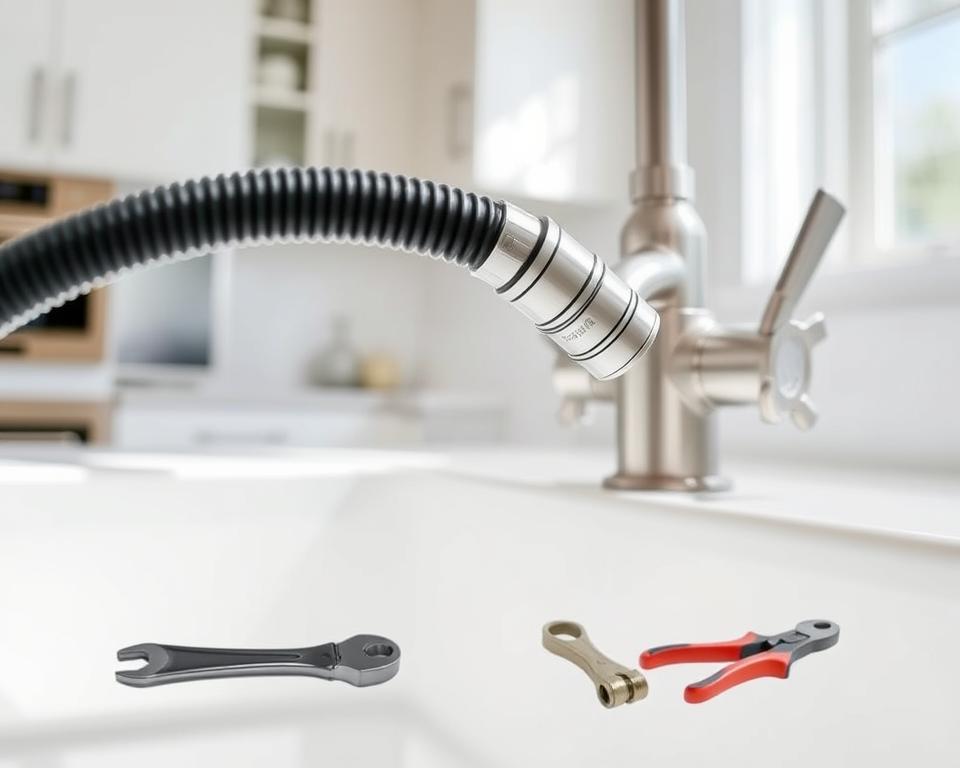Ultimate Manual to Kitchen Sink Hose Connections
Did you know installing a kitchen sink hose attachment may lower your utility costs? Although the exact savings fluctuate, the addition carries significance. A top-tier kitchen sink hose attachment boosts both performance and sustainability, upgrading any kitchen. This comprehensive handbook examines their significance, benefits, and how they revolutionize regular kitchen duties, such as produce cleaning and plate washing.
Variants from 2016 and 2017 differ in durability and practicality. Regardless of their release period, accurate setup is crucial; this typically requires removal of strainers or screens, a must in every instance. Routine servicing is also imperative to keep kitchen faucet head adapter in prime condition.
At Installation Parts Supply, we supply a diverse selection designed for different sinks, focusing on durability and usefulness. In the following, we examine the varieties, perks, and upkeep for kitchen sink hose attachments.
Summary Points
- Mounting a kitchen sink hose attachment can lower utility expenses.
- Proper installation guarantees optimal operation; removing filter strainers is a vital measure.
- Upkeep your hose attachment by periodically cleaning it.
- Material choice impacts longevity; PVC is prevalent but may crimp.
- Checking for leaks after setup is critical for effective performance.
- Utilizing high-quality clamps enhances lifespan and pressure resistance.
- Explore varieties at Installation Parts Supply for diverse kitchen demands.
Getting Started to kitchen sink hose Attachments
A kitchen sink hose attachment links with your faucet to simplify water flow control. They are offered in types like brass and quick connect. This design enhances maneuverability, enabling users to reach tough spots effortlessly. An cost-effective attachment boosts kitchen performance and streamline duties.
Defining a kitchen sink hose Accessory?
This attachment incorporates a flexible hose that extends water flow directly to the required area. Manufactured from materials like brass-finished and polymer, offering durability choices. Boasting both pull-out and pull-down designs, they work well for multiple functions. Among these are dish rinsing and washing produce.
Merits of Utilizing a kitchen sink hose Device
Kitchen sink hose attachments offer a multitude of advantages. They facilitate versatile water flow regulation, optimizing water dispersion and orientation. This adaptability aids in cleaning narrow areas or large objects. Installation is straightforward, requiring no professional help. With varied cost ranges, it’s simple to locate a cost-effective choice, while seamlessly upgrading your kitchen.
Types of kitchen sink hose Attachments
Identifying the right kitchen sink hose attachment is key to satisfying your requirements. Every model serves distinct purposes, boasting special advantages. Getting to know both bendable and rigid choices, alongside garden hose connectors, boosts your kitchen’s practicality.

Pliable kitchen sink hose Devices
Flexible kitchen sink hose attachments provide unparalleled flexibility. Ideal for accessing tricky spots around the sink, they render dish rinsing or washing fruits and vegetables a simple task. Their capability to maneuver into narrow spaces is highly valued. Their appeal of these attachments continues to grow due to their utility and user-friendliness.
Rigid kitchen sink hose Add-ons
Rigid kitchen sink hose attachments excel in their steadiness, delivering consistent water flow. They are crucial for filling containers or rinsing big items with effortlessness. Made of robust materials like stainless steel, they resist wear and tear efficiently. Consumers prefer these for their anti-leak properties, confirming their dependability for regular use.
Connectors for Garden Hoses
Adapters for garden hoses link kitchen faucets with outdoor hoses with ease. They’re a boon for outdoor chores, ranging from garden watering to cleaning outdoor furniture. These adapters minimize manual work, sparing homeowners from hauling water-filled buckets. By allowing most faucets to link with garden hoses, they offer wide adaptability and user-friendliness.
Selecting the Optimal kitchen sink hose Accessory
Choosing the right kitchen sink hose attachment involves considering several factors. Such considerations enhance both performance and usability in your kitchen space. It is vital to look for products that promise long-lasting performance and are made from premium materials. Simple installation and the fitting of the attachment with your sink play a pivotal role in selecting the best option.
Longevity and Build Quality
In your search for a lasting kitchen sink hose attachment, focus on the construction materials. Selections including stainless steel, granite, and high-grade plastics offer durability. They are known for their resistance to wear and tear. Opting for a long-lasting variant, you ensure years of reliable performance, keeping it in optimal condition despite frequent handling.
Simple Setup
A kitchen sink hose attachment with simple installation facilitates the complete installation. Numerous options are designed for straightforward installation, intended for users without advanced technical skills. Select an attachment that features simple instructions and every required component. This guarantees a swift and uncomplicated installation process.
Fit with Your Sink
Ensuring your kitchen sink hose attachment fits your sink is essential. Typically, sinks include pre-drilled holes for this purpose. It’s vital to select an attachment that matches your sink’s design. Proper compatibility prevents issues such as drips, making sure your attachment functions seamlessly.
Easy Installation of kitchen sink hose Devices
Mounting a kitchen sink hose attachment can seem daunting. Nonetheless, a simple sequence of steps makes easier the process. This simple method guarantees anyone to improve their kitchen’s efficiency. It describes a comprehensive procedure for fitting a kitchen sink hose, including the required equipment.
Step-by-Step Setup Instructions
Start by assembling all necessary materials and tools. Use an aerator removal tool to unscrew the faucet’s aerator. Check whether your faucet features male or female threads for attachment compatibility. Use Teflon tape around the faucet spout to ensure a tight, watertight seal.
Next, secure the suitable faucet adapter. Make sure it is tightly secured to stop dripping. Install a rubber gasket for a firm bond; this should prevent any water leaks if done right. Use vinyl grip tape over the wrench to prevent surface damage. Exercise extra care so as not to strip the threads, which can harm the faucet.
If lacking a vacuum breaker, adding a hose-type vacuum breaker is wise for system integrity. Always depressurize the hose before removal to avoid water splashing.
Required Tools
| Instrument | Function |
|---|---|
| Aerator Removal Tool | To detach the aerator from the faucet |
| Teflon Tape | Apply tape around the faucet spout to ensure a leak-proof seal |
| Adjustable Tool | Fasten the faucet adapter safely |
| Rubber Gasket | Create a secure seal to stop leaks |
| Vinyl Adhesive Tape | Shield surfaces from scratches during use |
Maintaining Your kitchen sink hose Device
To ensure your kitchen sink hose attachment works well and lasts long, routine upkeep is essential. Through using effective cleaning techniques and recognizing the need for replacement, you can prevent bigger problems down the line.
Cleaning and Care Tips
Maintaining the cleanliness of your kitchen sink hose attachment is essential for its performance. White vinegar, with its 5-10 percent acetic acid content is excellent for dissolving mineral build-ups that result in obstructions. Below are useful cleaning suggestions:
- Immerse the sink sprayer cover in vinegar for at least 1.5 hours to ensure complete cleaning.
- In legacy models, dismantle the sprayer so as to immerse its parts like the pierced disk, covering sleeve, and washers.
- In modern versions, merely turn the spray head anti-clockwise to gain access to its inside elements.
- Another technique for recent sprayer models is to dip them in a vinegar-filled bag, making sure the sprayer is entirely submerged, for an identical period of 1.5 hours.
Because hard water minerals are a common cause of clogs in sink sprayers obstructions, routine cleaning is necessary for smooth operation.
When to Change Your Hose Attachment
Recognizing when it’s time to replace your kitchen sink hose is crucial to avoid plumbing headaches. Be alert to these indicators:
- Leaks often mean the hose material is failing, which means it’s time for a new one.
- Noticeable fissures in the hose suggest a decline in integrity.
- A decrease in water flow may signal blockages or damages, indicating that replacement is necessary.
Regular proactive care of your kitchen sink hose attachment can significantly increase its durability, keeping your kitchen running efficiently.
Conclusion
Incorporating a kitchen sink hose attachment can greatly improve your kitchen’s efficiency. Our comprehensive guide explored the categories, advantages, and care guidelines of hose attachments. If you want to improve your kitchen duties or refresh your environment, a hose attachment offers adaptability and efficiency.
Such devices offer better heat management and liquid distribution. They make removing food debris easy, maintaining a clean area. Their merits in routine kitchen use are clear, streamlining your cleaning process substantially.
Improving your kitchen isn’t as challenging or expensive as it might seem. With options for every budget and design preference, a kitchen sink hose attachment has the potential to revolutionize your culinary space. By choosing quality options, like those from Installation Parts Supply, you ensure long-lasting use and happiness.
Common Inquiries
Defining a kitchen sink hose attachment?
The accessory connects with your faucet, turning it into a water sprayer. Such a change enhances water usage flexibility. It simplifies activities such as cleaning and gardening.
How do I install a kitchen sink hose attachment?
When setting up, begin by removing your faucet’s aerator. Then attach the correct faucet adapter. Confirm that every joint is tight and sealed. You’ll likely need an adjustable wrench and Teflon tape.
What should I consider when choosing the best kitchen sink hose attachment?
In choosing, prioritize durability, material quality, ease of installation, and how well it fits your sink and faucet. Stainless steel or superior plastics offer more durability.
Are kitchen sink hose attachments are simple to care for?
Absolutely, they are easy to maintain. Use vinegar for cleaning to eliminate mineral buildup. Regularly inspect for leaks and clogs. Consider replacing it if it becomes cracked, leaky, or hampers water flow.
May I use a kitchen sink hose attachment for outdoor tasks?
Absolutely, when used with garden hose adapters, it works excellently for outdoor chores like watering the garden.
Can I find budget-friendly kitchen sink hose attachments?
Absolutely, the market offers many cost-effective selections. Installation Parts Supply offers a range that marries affordability with quality.
How do flexible and rigid hose attachments differ
Devices with flexible hoses flexibly adjust to obscure angles, increasing adaptability for multiple applications. Stiff hose attachments keep their form, providing stable water flow control. They are typically sturdier.


